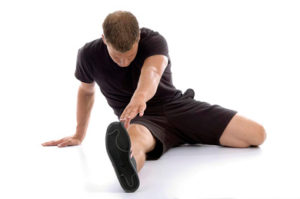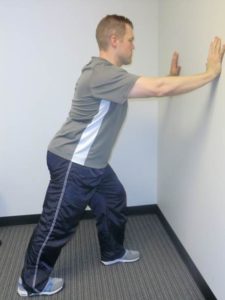When Should You Do Stretching Exercises?
A majority of our patients here are an active bunch. They lead active, purposeful lives and do a wide array of physical activities. They’re always asking us about stretching. Routintely, we get asked how long to hold stretches, when to do them, and which ones to do. For seemingly years, it has been an accepted dogma that you must stretch before exercise, although no research proves that it’s necessary for injury prevention. A review by Witvrouw et al (Sports Med, 2004) showed that there is an obscure relationship between stretching and injury prevention. Thacker et al found in a systematic review of literature that there is no evidence to endorse or discontinue stretching before or after exercise to prevent injury. Intuitively, it would seem that it can’t be true, but the research has not shown otherwise. We imagine the reason that it’s always been assumed that we should stretch before exercise because the perception is that if you go into an exercise or competitive session “tight” you are at risk for injury. Clinical experience and the literature reveals that this argument is partly true.


Different Types of Stretching
First of all, it’s important to understand the different types of stretching. Static stretching is what we’re most familiar with – placing a muscle or joint on stretch and holding the stretch position. For example, placing your foot on a chair to stretch your hamstring. Now, static stretches can be active or passive. Active is when you do it yourself and determine amount of stretch, or passive when someone does it for you. Dynamic stretching is basically stretching while moving. An example of dynamic stretching is doing lunges with exaggerated steps, doing “high knees” while running, etc. Finally, PNF (proprioceptive neuromuscular facilitation) is the last type. Here, a muscle is stretched by contracting the opposing muscle. PNF is used both for flexibility, strengthening, and for rehab. It is an excellent treatment tool.
Static stretching (place and hold) has been shown to actually decrease acute strength and power. Winchester and others (J Strength Cond Res, 2008) have found that it impairs sprint performance and Robbins et al (J Strength Cond Res, 2008) found that it adversely affected vertical jump performance. Other studies have substantiated these conclusions. The proposed reason that this occurs is basically due to muscle’s length-tension relationship. Essentially, muscle physiology principle says that the muscles contractile proteins (actin and myosin) are supposed to have an optimal position so maximize muscle function. It is believed that acute bouts of stretching increases that length and subsequently decreases the ability of the muscle to contract at its best.


All that being said, the trend is shifting in that performing dynamic stretching before exercise is the best way to “stretch” before exercise. Ce et al (J Strength Cond Res, 2008) and Manoel et al (J Strength Cond Res, 2008) are just two groups of researchers that have recently found that dynamic stretching is the optimal way to increase power prior to sport performance. First of all, because it’s dynamic, you are moving and you’re likely to work up a sweat. If you are sweating, there is increased blood flow which has been shown to increase tissue extensibility. The problem with static stretching is that in order to get benefit, you can’t be “cold”. By “getting hot”, your tissues are more elastic and ready for activity. Examples of dynamic stretching are walking lunges, jumping jacks, high knees, butt kickers, and squats just to name a few. Here’s a link to a clip on some good ideas for dynamic stretching.
Best Approach to Stretching
So, what’s the best way to stretch? We always prefer a general warm up first. A bike, a short jog, an elliptical trainer, or stair stepper is just a way to get the heart rate up and work up a sweat. After a 5-10 minute warm up, we suggest performing a specific or dynamic warm up. Here, they’ll perform a series of movements in the upper and lower extremities. Lunges, mountain climbers, jumping rope, and arm circles are just a few examples that would follow for another 5-10 minutes. We encourage athletes to continue moving and take no rest between these movements to keep the heart rate up. After this is done, you should be ready to move into your workout.
Once the session is done, a brief stint on a bike or a short jog is a good way to “flush” the body of waste products created during exercise to help minimize delayed onset muscle soreness (DOMS). We assure you’ve had DOMS if you woke up the morning after an intense workout and could barely walk! You might consider foam rolling too. After the cool down period, close with static stretching. In theory, static stretching should be more productive at this point because the tissues are much warmer and more extensible at this time as opposed to being “cold” prior to any exercise.
How Long Should You Hold Stretches?
Two studies by Bandy and others (Phys Ther, 1997) have shown that holding stretches for 30 seconds is the optimum time frame to hold a stretch for acute increases in flexibility. The “rub” here is that you aren’t going to sustain the new length unless you consistently stretch.
Summary on Stretching
1. Warm up with light exercise, like jogging, biking, or the elliptical, followed by dynamic flexibility like lunges, high knees, “butt kickers”, etc. Do not perform static stretches BEFORE activity.
2. Static stretches AFTER activity.
3. Hold stretches 30 seconds – no more, no less.
It would be a privilege to serve you and partner with you in your care. Remember, in the state of Kansas, you can see a physical therapist without a physician referral. (913) 728-8599 Our team of physical therapists are competent, professional, and will give you specific tasks to achieve your goals.
Tags: Kansas City, Overland Park, physical therapist, Physical Therapy, prairie village, sports physical therapist, stretching
